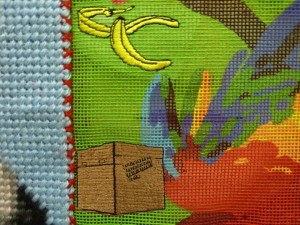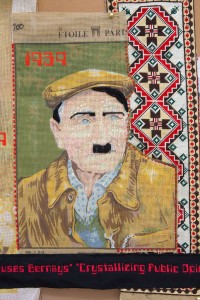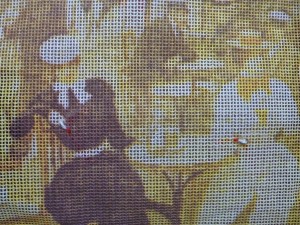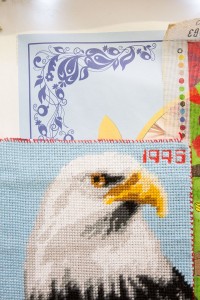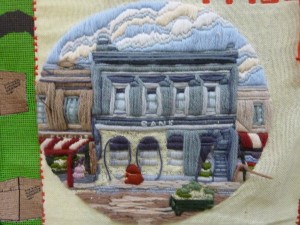 This work comprises over forty tapestries bought from a disability service stitched to explore the intersections of economics, psychology and advertising. It shows some of the successful campaigns Edward Bernays devised on behalf of government and corporations in a predominantly European and American story. The tapestry’s beginning book-end is the specific event that has shaped the way that Australia has approached policy in relation to the commons and the enclosure. The Irish Potato Famine Genocide of 1845 involved the government prioritising social policy as an epiphenomenon of the economy. The tapestry ends with Burson-Marsteller’s Energy Poverty campaign to show how the stage has been reached where a version of the Irish Potato Genocide is now being implemented on our general population with consent.
This work comprises over forty tapestries bought from a disability service stitched to explore the intersections of economics, psychology and advertising. It shows some of the successful campaigns Edward Bernays devised on behalf of government and corporations in a predominantly European and American story. The tapestry’s beginning book-end is the specific event that has shaped the way that Australia has approached policy in relation to the commons and the enclosure. The Irish Potato Famine Genocide of 1845 involved the government prioritising social policy as an epiphenomenon of the economy. The tapestry ends with Burson-Marsteller’s Energy Poverty campaign to show how the stage has been reached where a version of the Irish Potato Genocide is now being implemented on our general population with consent.
The work is part of a tapestry series that includes Halley’s Sky News: alienation, law & the environment and Birds watch New Kingdom nobles pass Self-Service Wells Act at the Nile Basin Authority.
Work’s teletext strip: 1897 Irish potato genocide. 1910 Halley’s Comet. 1914 Freud’s libidinal economy. 1929 His nephew Edward Bernays, father of public relations USA, sells women cigarettes ‘torches of freedom’. 1939 ‘Progress’. 1939 Goebbels uses Bernays’ ‘Crystallizing Public Opinion’.1945 Bernays’ peacetime influence. 1945 $US diplomacy. 1959 Bernays, CIA & United Fruit oust Guatemalan president. 1965 Freud’s daughter Anna rolls out USA super-ego programs. 1960s Freedom to desire & brand choices. Lifestyle research replaces policy. 1970s Banks support speculation not production. 1980s 3rd world labour. 1985 Halley’s Comet. 1990s Swing-voter lifestyle focus groups. 2011 Housing market up 8000% from mid-50s. Burson-Marsteller’s energy poverty campaign. ‘We use what Bernays identified’.
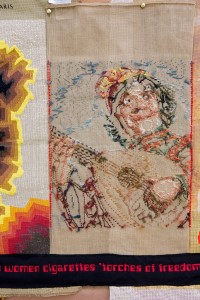 The tapestry draws from The Century of the Self (2002), a cogent argument presented by British journalist and filmmaker, Adam Curtis, who examines the life of Edward Bernays. The tapestry chronologically presents specific negative influences that Bernays created on behalf of governments and corporations. Bernays invented public relations in America by applying his Uncle Sigmund Freud’s ideas for mass control.
The tapestry draws from The Century of the Self (2002), a cogent argument presented by British journalist and filmmaker, Adam Curtis, who examines the life of Edward Bernays. The tapestry chronologically presents specific negative influences that Bernays created on behalf of governments and corporations. Bernays invented public relations in America by applying his Uncle Sigmund Freud’s ideas for mass control. 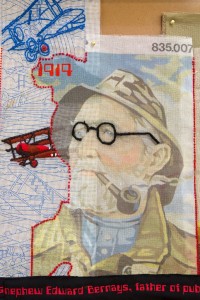
These influences were turning points in the use of control of the ways in which Americans related to commodification, modern consumerism and representative democracy. These shifts have followed since in Australia. As a result of the way the tapestry work clearly articulates the influences that have caused these changes, it creates access points from which individuals and groups can rethink these relationships.
The CIA, Bernays and United Fruit Company (now Chiquita Brands International) oust Guatemalan government. Tapestry incorporates a representation of Hans Haacke’s U.S. Isolation Box, Grenada, 1983.
Goebbels uses Bernays’ ‘Crystallizing Public Opinion’.
Representative democracy has traditionally been about engaging people’s rational conscious minds and facilitating their needs as a society. However, since around 1925 when Bernays drew from his uncle’s work in psychoanalysis, politicians have appealed to irrational, primitive impulses that have little apparent bearing on issues outside the narrow self-interest of a consumer population. 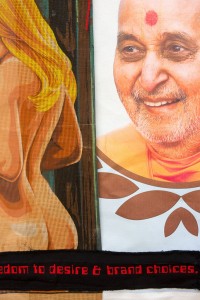 Alongside this, modern consumerism shifted to a desire culture that was instigated because those in power were led to believe by the ruling class that mass production could lead to high unemployment or overproduction in a stable economy. People were trained to desire and want new things even before the old had been consumed, and so Bernays and then later a whole advertising industry manipulated consumer behaviour in the interests of manufacturers.
Alongside this, modern consumerism shifted to a desire culture that was instigated because those in power were led to believe by the ruling class that mass production could lead to high unemployment or overproduction in a stable economy. People were trained to desire and want new things even before the old had been consumed, and so Bernays and then later a whole advertising industry manipulated consumer behaviour in the interests of manufacturers.
 Bernays invented the World Fair on behalf of corporations to change popular opinion so that they are known to be responsible for ‘progress’, rather than governments.
Bernays invented the World Fair on behalf of corporations to change popular opinion so that they are known to be responsible for ‘progress’, rather than governments.
Women were targeted particularly because of statistical evidence claiming women make eighty-five percent of all consumer purchases. Bernays’ ‘torches of freedom’ campaign broke the taboo of women smoking cigarettes.
As part of the indoctrination, Americans were trained to turn a blind eye to social inequities, to construct individual subjectivities around the purchase of commodities, and to view democracy as the freedom to choose between brands.[1]
Set against a backdrop of progressively violent strikes and protests, a new form of fear-driven domination was added to the classic version of imperialism that required the cooption of the working class through the promise of riches from the colonial areas.
Exploitative colonial relationships were brought into the domestic arena, linking the new consumerism with class and social aspirations to lay the seeds for the neoliberal governmentality and globalisation that has since followed.
US Dollar hegemony.
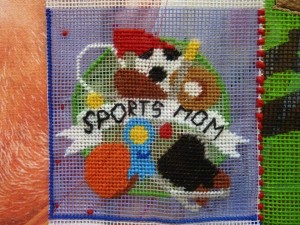
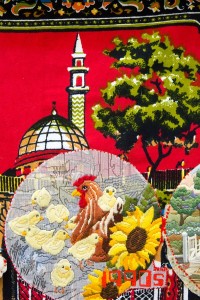 Voters were determined according to lifestyles and then policy was replaced with decisions made by swing-voter lifestyle focus groups.
Voters were determined according to lifestyles and then policy was replaced with decisions made by swing-voter lifestyle focus groups.
 Banks continued to support speculation rather than production.
Banks continued to support speculation rather than production.
The housing market increases 8000% from the mid-50s.
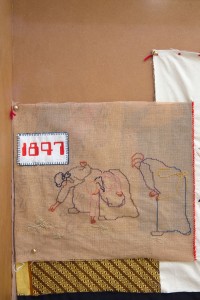 The predominantly European and American story presented in the tapestry is book-ended at the beginning by a specific event that has shaped the way that Australia has approached policy in relation to the commons and the enclosure. The Irish Potato Famine Genocide of 1845 involved the government prioritising social policy as an epiphenomenon of the economy.
The predominantly European and American story presented in the tapestry is book-ended at the beginning by a specific event that has shaped the way that Australia has approached policy in relation to the commons and the enclosure. The Irish Potato Famine Genocide of 1845 involved the government prioritising social policy as an epiphenomenon of the economy.
The tapestry’s story shows how the stage has been reached where a version of the Irish Potato Genocide is now being implemented on our general population with consent. The work ends with Burson-Marsteller’s Energy Poverty campaign.
 Burson quotes that their company continues to implement what Bernays identified decades earlier.
Burson quotes that their company continues to implement what Bernays identified decades earlier.
1. Marlis Schweitzer. When Broadway was the runway: Theatre, Fashion and American Culture. (Philadelphia, PA: University of Pennsylvania Press, 2009), 57.
